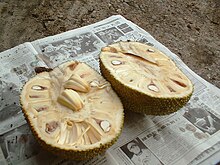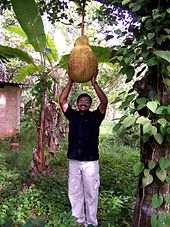| Jackfruit | |
|---|---|
 | |
| Jackfruit tree with fruit | |
| Scientific classification | |
| Kingdom: | Plantae |
| Division: | Magnoliophyta |
| Class: | Magnoliopsida |
| Order: | Rosales |
| Family: | Moraceae |
| Tribe: | Artocarpeae |
| Genus: | Artocarpus |
| Species: | A. heterophyllus |
| Binomial name | |
| Artocarpus heterophyllus Lam. | |
| Synonyms | |
It is well suited to tropical lowlands. Its fruit is the largest tree-borne fruit in the world,[2] reaching 80 pounds (36 kg) in weight and up to 36 inches (90 cm) long and 20 inches (50 cm) in diameter.[3]
Contents |
Etymology and names
The name "Jack fruit" is derived from the Portuguese Jaca,[4] which in turn, is derived from the Malayalam language term, Chakka.[5] The Portuguese first arrived in India at Kozhikode (Calicut) on the Malabar Coast (Kerala) in 1498. The Malayalam name Chakka was recorded by Hendrik van Rheede (1678–1703) in the Hortus Malabaricus, vol. iii in Latin. Henry Yule translated the book in Jordanus Catalani's (1678–1703) Mirabilia Descripta: The Wonders of the East.[6]The fruit is called a variety of names around the world. The common English name jackfruit is a name used by the physician and naturalist Garcia de Orta in his 1563 book Colóquios dos simples e drogas da India.[7][8]
A botanist, Ralph Randles Stewart suggests that it was named after William Jack (1795–1822), a Scottish botanist who worked for the East India Company in Bengal, Sumatra and Malaysia.[9] This is unlikely, as the fruit was called a "Jack" in English before William Jack was born: for instance, in Dampier's 1699 book, A new voyage round the world.[10].
Cultivation and ecology
The jackfruit has played a significant role in Indian agriculture for centuries. Archeological findings in India have revealed that jackfruit was cultivated in India 3000 to 6000 years ago. Findings also indicate that Indian Emperor Ashoka the Great (274–237 BC) encouraged arbori-horticulture of various fruits including jackfruit. Varahamihira, the Indian astronomer, mathematician, and astrologer, wrote a chapter on the treatment of trees in his Brhat Samhita. His treatise includes a specific reference on grafting to be performed on trees such as jackfruit.[11] Maturing in 35-40 years, their wood can be used for furniture. The gum from this tree is used to repair small holes in pots. In Kerala (India), Jackfruit tree supports the Black Pepper vine, which is a climber. Thus the trunks of Jackfruit trees of Kerala are usually covered with the dark green leaves of the pepper vine cultivated by the farmers.Commercial availability
Outside of its countries of origin, fresh jackfruit can be found at Asian food markets especially in Philippines. It is also extensively cultivated in the Brazilian coastal region, where it is sold in local markets. It is available canned in sugar syrup, or frozen. Dried jackfruit chips are produced by various manufacturers. In northern Australia, particularly in Darwin, Australia, jackfruit can be found at outdoor produce markets during the dry season. Outside of countries where it is grown, jackfruit can be obtained year-round both canned or dried. It has a ripening season in Asia of late Spring to late Summer.[13]Jackfruit
The flesh of the jackfruit is starchy, fibrous and is a source of dietary fiber. The flavour is similar to a tart banana. Varieties of jackfruit are distinguished according to the characteristics of the fruits' flesh. In Brazil, three varieties are recognized. These are: jaca-dura, or "hard" variety, which has firm flesh and the largest fruits that can weigh between 15 and 40 kilograms each; jaca-mole, or "soft" variety, which bears smaller fruits, with softer and sweeter flesh; and jaca-manteiga, or "butter" variety, which bears sweet fruits, whose flesh has a consistency intermediate between the "hard" and "soft" varieties.[14]In Kerala, mainly two varieties of Jackfruit are found: Varikka and Kuzha. Varikka has slightly hard flesh for the inner fruit when it becomes ripened. Kuzha fruit has very soft, almost dissolving type flesh for the inner fruit on ripening. A sweet preparation called Chakka Varattiyathu is made by seasoning the Varikka fruit flesh pieces in jaggery, which can be preserved and used for many months. Huge jackfruits up to 4 feet length with matching girth are sometimes seen in Kerala.
Dishes and preparations
Jackfruit is commonly used in South and Southeast Asian cuisines.[15] It can be eaten unripe (young) when cooked, or ripe uncooked.[15] The seeds may be boiled or baked like beans. The leaves are used as a wrapping for steamed idlis.Young fruit
The young fruit is called Polos in Sri Lanka, and 'Idichakka" in Kerala. It is a wonderful dish with spices to replace meat curries in Sri Lankan cuisine. The skin of unripe (young) jack fruit must be pared first and discarded and then the whole fruit can be chopped into edible portions and cooked to be eaten. The raw young fruit is not edible.[15] Young jackfruit has a mild flavour and distinctive texture. The cuisines of India, Nepal, Bangladesh, Sri Lanka, Indonesia, Cambodia, and Vietnam use cooked young jackfruit.[15] In Indonesia, young jackfruit is eaten as gudeg. In many cultures, jackfruit is boiled and used in curries as a staple food.Wood
The wood of the tree is used for the production of musical instruments. In Indonesia it forms part of the gamelan and in the Philippines, its soft wood is made into the hull of a kutiyapi, a type of Philippine boat lute. It is also used to make the body of the Indian string instrument Veena and the drums Mridangam and Kanjira, the Golden yellow coloured timber with good grains is used for building furniture and house construction in India. The ornated wooden plank called Avani Palaka made of the wood of Jackfruit tree is used as the priest's seat during Hindu ceremonies in Kerala.Jackfruit wood is widely used in the manufacture of furniture, doors and windows, and in roof construction.
The heartwood of the jackfruit tree is used by Buddhist forest monastics in Southeast Asia as a dye, giving the robes of the monks in those traditions their distinctive light brown color.[16]







No comments:
Post a Comment